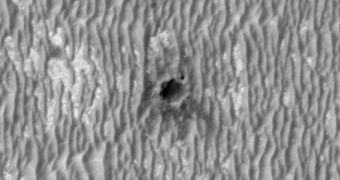MER mission managers from the NASA Jet Propulsion Laboratory (JPL), in Pasadena, California, announce that the rover Opportunity has just finished a six-week-long analysis of an odd, young crater. Called Concepción, the formation is no larger than ten meters (or 33 feet) in diameter, but it proved to be very interesting from a geological perspective. As the rover was investigating it, the NASA Mars Reconnaissance Orbiter (MRO) spacecraft snapped a photo of the two from the Red Planet's orbit.
Though the explorations robot accumulated impressive amounts of data on the crater during its six-week stay, preliminary analysis results have left geologists and planetary scientists just as puzzled as they were before beginning the investigation. Rock layers next to the small crater revealed a weird-looking coating, whose composition is still a mystery to researchers. In addition, the structure is surrounded by dark rays, as seen from above, which means that it is relatively very young. This recommended it as a certain target for investigations by Opportunity.
Since the rover landed on the Red Planet, in 2004, it has always navigated above the same type of ground – soft, sulfate-rich sandstone. These lands feature harder, peppercorn-size, dark spheres, which geologists say resemble berries in a muffin. They are also very rich in iron deposits, experts say, and they are generally referred to as “blueberries.”
“It was clear from the images that Opportunity took on the approach to Concepción that there was strange stuff on lots of the rocks near the crater. There's dark, grayish material coating faces of the rocks and filling fractures in them. At least part of it is composed of blueberries jammed together as close as you could pack them. We've never seen anything like this before,” the principal investigator for the MER mission, Steve Squyres, says. The expert holds an appointment at the Ithaca, New York-based Cornell University. He is the person in charge with analyzing the data that Opportunity and Spirit send back from Mars.
“One consideration that jumps out is that we've been driving around this part of Mars for six years and never seen this stuff before, then we get to this young crater and it's coating rocks all around the crater. Sure looks like there's a connection, but it could just be a coincidence,” Matt Golombek, who is a member of the science team managing the two rovers, says.

 14 DAY TRIAL //
14 DAY TRIAL //